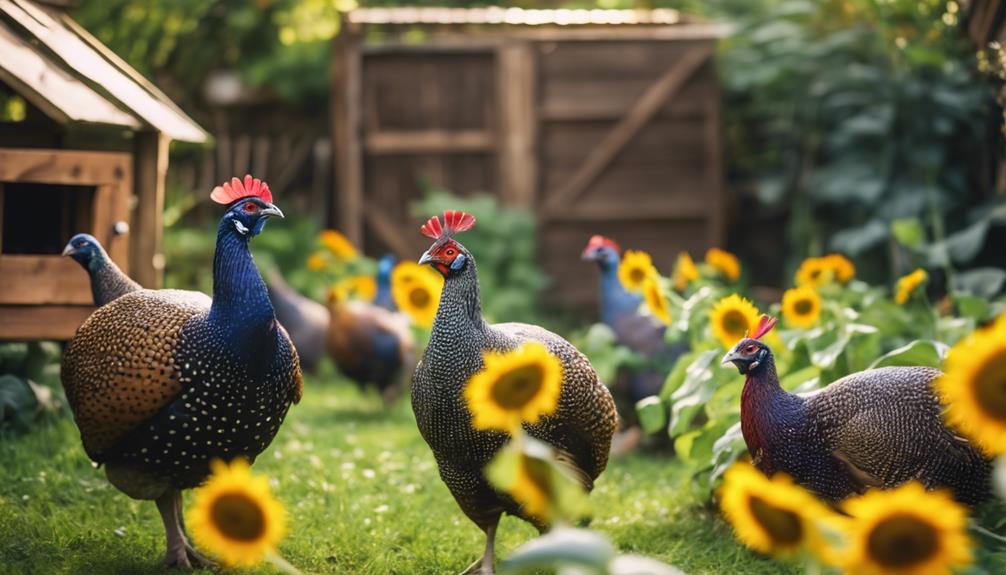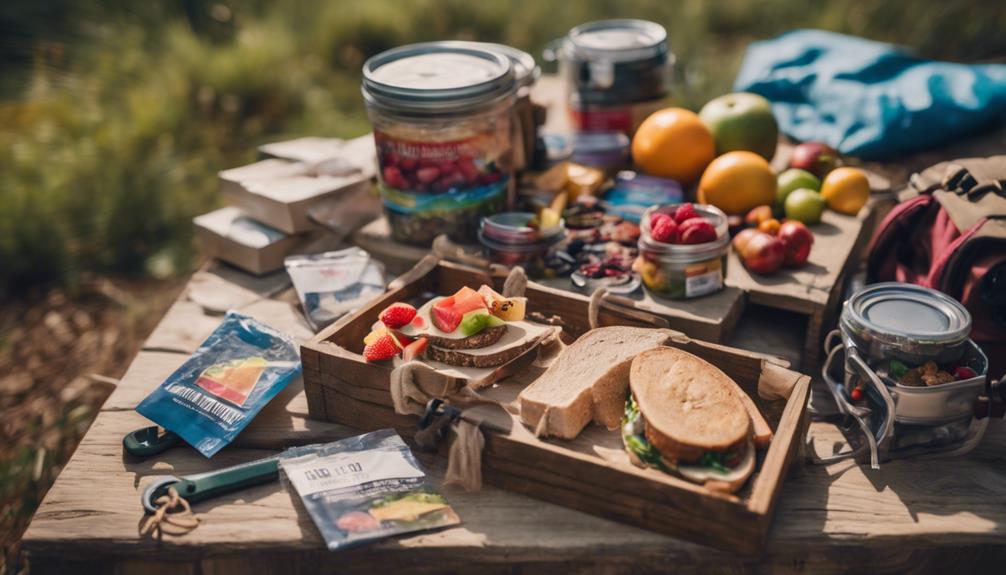Guinea fowl are crucial for homesteading, offering natural pest control and acting as an alert system against predators. They thrive in various climates and require low maintenance, making them perfect for busy owners. Various breeds, like Pearl Grays and Jumbo Lavenders, provide unique traits suited to different needs. They need spacious habitats, dust baths for health, and a high-protein diet for ideal growth. Proper handling and social interaction are essential to maintain a harmonious flock. With these insights, homesteaders can effectively integrate guineas into their farm ecosystem, and more valuable tips await those looking to enhance their setup.
Key Takeaways
- Guineas provide excellent natural pest control, targeting ticks and mice while promoting a healthier garden and farm ecosystem.
- They require spacious habitats with dust baths and well-lit areas to thrive and maintain their health.
- A high-protein diet is essential, with keets needing 25% protein and adults requiring 16% for optimal growth and health.
- Regular monitoring of social dynamics is crucial to prevent aggression, ensuring harmonious interactions with other poultry.
Importance of Guineas in Homesteading
Guineas play an essential role in homesteading by providing natural pest control and enhancing security, making them invaluable companions for any self-sufficient lifestyle. They effectively target pests like ticks and mice, contributing to the health of gardens and farms.
Their loud shrieks act as an early warning system against predators, increasing overall security. Guineas are also protective, often fighting to defend their flock from threats.
Originating from West Africa, these adaptable birds thrive in various climates and environments. Plus, they're low-maintenance due to their free-ranging habits and minimal feed requirements, making them ideal for preppers.
With the added benefit of meat and eggs, guineas truly enrich the homesteading experience.
Varieties of Guinea Fowl
A variety of guinea fowl exists, each showcasing unique colors and characteristics that enhance their appeal to homesteaders. These diverse varieties not only add visual interest to a homestead but also offer different traits that can suit various needs. Below is a concise overview of some popular guinea varieties:
| Variety | Characteristics |
|---|---|
| Pearl Grays | Calm, easy to train, black and tan patterns |
| Jumbo Lavenders | Light blue feathers, can weigh up to 7 lbs |
| Coral Blues | Distinct coral blue features on legs and beaks |
| Standard Lavenders | Similar to jumbo, more orange accents |
Habitat and Care Requirements

Creating a spacious and secure habitat is essential for guineas to thrive and perform their natural behaviors effectively. They need tall, open runs that allow them to roam freely and express their independent nature.
Regular dust baths help control mites and parasites, so providing a designated area for this activity is critical. Guineas prefer well-lit spaces, and using solar-powered lights can reduce stress in coops. Additionally, offering clean, dry sand or dirt in the dust bath area ensures optimal effectiveness in removing pests. Alongside maintaining a pest-free environment, using proper composting techniques for healthy gardens can make use of guinea droppings, enriching the soil naturally. This sustainable approach promotes a healthier ecosystem while supporting both your flock and your garden.
It's important to maintain a proper diet, with keets requiring 25% protein feed, while adults need 16%. Monitoring food and water is essential, especially during winter months when free-ranging may be limited.
A recommended breeding ratio is one cock per five hens to guarantee ideal reproduction and care.
Feeding Guidelines for Guineas
Proper nutrition is essential for guineas to thrive and maintain their health throughout various life stages.
Keets require a high-protein diet of 25% protein feed to support their rapid growth, while juveniles need 20% protein. Mature guineas should have a diet containing 16% protein, which can be adjusted during winter months.
Free-ranging guineas can supplement their diet with foraged insects and plants, but supplemental feeding may be necessary if they aren't foraging adequately.
Providing clean, fresh water daily is vital for their hydration. Regularly check their feeding stations to guarantee they've enough food, and avoid damp feed to prevent illness.
Following these guidelines will help guarantee guineas remain healthy and productive in a homesteading environment.
Breeding and Incubation Process

Breeding guineas presents unique challenges, particularly when it comes to managing egg laying and keet care. Guinea hens typically prefer secluded nesting spots, making it vital for owners to monitor these areas.
The incubation period for guinea eggs lasts between 26 to 28 days, with temperatures maintained between 95 to 100 degrees Fahrenheit for best hatching. A guinea hen can incubate up to 15 eggs, so providing warm water with sugar can help boost the energy of newly hatched keets.
Setting up a proper brooder is essential; it should include shallow water containers, red heat lamps to prevent cannibalism, and perches for enrichment. Regularly checking food and water levels guarantees keets remain healthy and thriving.
Handling and Behavior Insights
Understanding guinea behavior is essential for effective management, as they display strong territorial instincts and can be resistant to handling. To successfully manage guineas, owners should adopt gentle approaches, minimizing stress during interactions.
Providing ample space and mental stimulation is vital to prevent boredom and subsequent aggression. Guineas thrive when allowed to express their natural behaviors, such as roaming and roosting outside in warm weather.
Their social dynamics can lead to pecking, so it's important to monitor group interactions. Additionally, while guineas can integrate with other poultry, care must be taken to avoid aggressive behavior, especially from roosters.
A relaxed environment helps foster positive behaviors, ensuring a harmonious homestead.
Integrating Guineas With Other Poultry

Integrating guineas with other poultry can create a dynamic and productive barnyard environment, but it requires careful consideration of their unique behaviors and social needs.
To successfully blend guineas with chickens or ducks, homesteaders should keep these points in mind:
- Space Requirements: Guineas need ample room to roam and establish their territory, reducing stress and aggression.
- Social Dynamics: Monitor interactions, as guineas can be loud and territorial, potentially causing friction with more docile breeds.
- Feeding Strategies: Guarantee all poultry have access to appropriate feed, as guineas' dietary needs differ from chickens and ducks.
When managed correctly, guineas can coexist harmoniously, contributing to a vibrant and efficient barnyard ecosystem.
Frequently Asked Questions
What Are Common Health Issues Faced by Guineas?
Guineas often face health issues like respiratory infections, mites, and parasites. They're susceptible to nutritional deficiencies, especially without a balanced diet. Regular monitoring and preventive care can help maintain their overall health and well-being.
How Long Do Guineas Typically Live?
Guineas typically live around five to seven years, though some can reach ten. Their lifespan reflects their hardiness and adaptability, making them a resilient choice for those seeking unique and beneficial additions to their homesteads.
Can Guineas Be Kept in Urban Settings?
Guineas can adapt to urban settings, provided there's sufficient space and proper care. They enjoy free-ranging and can help control pests, but their loud vocalizations may not suit every neighborhood. Consider local regulations before keeping them.
What Predators Are Most Dangerous to Guineas?
Like shadows in the night, predators threaten guineas, with raccoons, foxes, and hawks being particularly dangerous. These opportunistic hunters can strike swiftly, so keeping guineas secure is crucial to guarantee their safety and survival.
How Do Guineas Communicate With Each Other?
Guineas communicate through a variety of vocalizations, signaling excitement, alarm, or distress. Their loud shrieks alert others to potential threats, while softer calls indicate contentment, helping maintain social cohesion within their flock.
Conclusion
Incorporating guineas into homesteading not only enhances farm security but also promotes ecological balance.
With their impressive ability to consume up to 90% of ticks in a given area, these birds are a natural pest control solution.
Their low-maintenance nature and adaptability make them a perfect fit for sustainable living enthusiasts.
By embracing the unique benefits of guineas, homesteaders can create a more productive and secure environment, reaping rewards for years to come.










